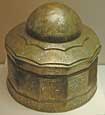
Iran, Fars. First half of 14th c. CE. Beaten copper alloy, engraved decoration, inlaid with silver, gold and niello. H.: 24.2, Dia. (base): 26.9 cm.A similar example, preserved in better condition, is in the City Art Museum in St. Louis.
Inv. no.: OA 3355. Website (with several detailed photos)
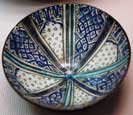
Iran, end of 13th-beg. of 14th c. CE. Fritware, underglaze painted.
Inv. no. MAO 831. Website

Iran, 13th c. CE. Fritware, moulded decoration under transparaent colored glaze. Influence of Chinese designs; forms popular in Seljuk period in Iran and Ayyubid in Syria.
Inv. no.: MAO 248.

Iran, Sultanabad (?). First half of 14th c. CE. Fritware, slip and underglaze painted decoration over slip. Form common earlier in Seljuk period; attests to influences from China.
Inv. OA 8207. Website
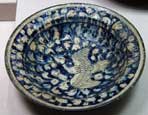
Iran, Sultanabad (?). 14th c. CE. Fritware, slip and underglaze paint over slip. A Chinese motif.
Inv. no.: MAO 381. Website. Cf. Freer Gallery, Inv. no.: F1947.9.
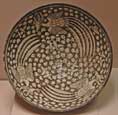
Iran, Sultanabad (?). 2nd half of 14th c. CE. Fritware, slip and underlaze paint over slip. H.: 21; Dia.: 25.4 cm. Mongol-period interpretation of Chinese subject matter.
Inv. no. OA 8177. Website. Cf.: LACMA Inv. no.: M.73.5.215.

Iran. 13th-14th c. CE. Fritware, underglaze painted. Form imitates Seljuk period metalwork.
Inv. no.: OA 6172. Website
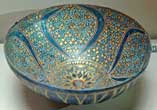
Iran, beg. of 14th c. CE. Fritware, overglaze low-fired technique with gilding, developed earlier by Seljuk ceramicists.
Inv. no. MAO 450. Website

Iran, beg. of 14th c. CE. Fritware, overglaze low-fired technique with gilding, developed earlier by Seljuk ceramicists. The fish-pond motif found in Iranian and Syrian-Egyptian metalwork.
Inv. OA 6430. Website
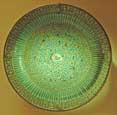
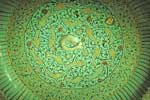
Iran, end of 13th-beg. of 14th c. Fritware, low-fired, gilded decoration over translucent colored glaze. Note: museum website photo shows blue color and describes it as having blue ground, although I remember it as the brilliant green shown here (cf. OA 6430, which is the lapis lazuli blue spoken of in the website description).
Inv. no.: OA 6456. Website

Iran, 13th c. CE. Earthenware, moulded decoration under colored translucent glaze.
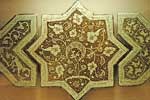
Iran, Kashan. 2nd half of 13th c. CE. Fritware, overglaze lustre painted. probably from tomb of Imamzada Yahya at Varamin S. of Tehran (660-662 AH/1261-1263 CE), One tile has date 5 June-3 July 1258. Inscription: Quran CXII.
Inv. no.: 4079, one of several pieces, not all on display. Website. Cf. Berlin MIK I.3864 and LACMA Inv. no.: M.2002.1.76.

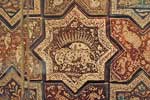

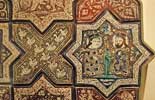
Iran, Kashan, 1267 CE/665 AH. Fritware, overglaze lustre with color splashes. The panel if from the tomb of imamazade Djafar at Damghan.
Inv. no.: OA 6319. Website (photo shows whole panel)
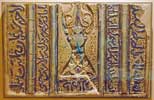
Iran, Kashan. 1289 CE/688 AH. Fritware, moulded decoration, overglaze lustre painted with color splashes.Inscription includes Quran sura XCVII: 3-5.
Inv. no.: OA 3342. Website (no photo yet)

Iran, Kashan. 13th-14th c. CE. Fritware, moulded decoration, overglaze lustre painted with color splashes. Inscription: Quran XL: 16=17; XLI: 30.
Inv. nos.: OA 3343, 3344. Website (no photo yet)